- See:
- Bilateral InterFacet Dislocation
- Hyperflexion Injuries
- Unilateral Facet Dislocation:
- Discussion:
- frequently missed in acute cervical spine trauma; (oblique radiograph views are important here);
- lateral mass frx is considered to be extension rotational injury;
- flexion of superior vertebral body usually does not occur, because subluxing inferior articularprocess does not have to ride up intact
superior process;
- inferior process fractures are typically at base of process and tend not to be associated
with neurologic deficit, because neuroforamen is not narrowed;
- w/ high-grade anterior subluxation (>/= 50%), there is little anterior shear resistance by the disk or ligaments;
- associated injuries:
- unilateral or bilateral facet joint subluxation or dislocation is seen;
- contralateral facet subluxation & anterolisthesis is common;
- apical frxs of superior process are usually assoc w/ transient high-grade bilateral facet subluxation and cord injury;
- w/ frx of articular process & subluxation or dislocation there is no longer bony resistance to forward
subluxation (superior articular process of lower vertebra is compromised);
- frx fragment may be small enough that remaining part of superior process provides an adequate bony block;
- laminar frx:
- may be missed on routine radiographs due to the obliquity of the lamina;
- facet frx which extend into the lamina will be more unstable and less amenable to closed treatment;
- neurologic findings
- basal frxs of superior process typically are assoc w/ root or cord deficit because vertebral
subluxation cannot be resisted by incompetent superior articular process;
- Radiographs of Facet Frx:

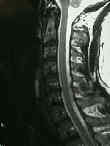
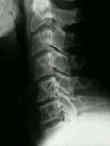
- AP
- disruption of undulating lataeral margin;
- Lateral View:
- facet injuries may be difficult to see on the lateral view due to overlap of both facets;
- Pillar View
- depicts the lateral mass en face;
- frx typically extends vertically thru articular mass & separate fragment, or fragments, may be depressed or displaced laterally;
- Oblique projections;
- articular process frx can be overlooked, if intervertebral realignment has already occurred spontaneously;
- look for discrete frx lines as well as facet disarticulation;
- pillar frx is usually visible in inferior articulating facet of involved mass;
- may not be visible is if vertical plane of frx line does not coincide with obliquity of projections;
- Non Operative Treatment:
- small apical frx of superior process w/o subluxation on dynamic lateral radiographs may be treated with an orthosis;
- Operative Treatment:
- displaced articular process frxs are treated w/ posterior wiring & grafting, because orthosis, including halo, may not maintain reduction
and prolonged traction may not be practical;
- spinous process wiring:
- alone may not provide derotating force needed to maintain realignment;
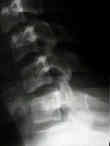
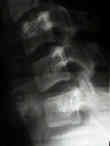
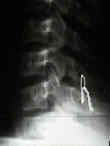
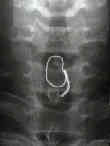
- oblique facet wiring technique:
- wire passes thru inferior articular process then around spinous process of subjacent vertebra;
- it resists both forward & upward motion of inferior facet process
References
Facet fracture-dislocation injuries of the cervical spine.
Unilateral facet dislocations and fracture-dislocations of the cervical spine.

